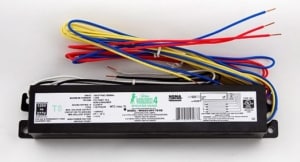Replace Ballast Lighting With Energy-Efficient Options

Ballast lighting is a standard for fluorescent lighting in a myriad of applications. They are often used in offices, retail settings, schools, hallways, and cafeterias. They provide expansive lighting compared to other sources but they are not the most energy efficient. There are a few negatives to using ballast lighting and switching to energy-efficient options is a great way to save money on energy bills and increase the lifespan of the bulbs themselves. Let’s look into why you should replace ballast lighting with energy-efficient options.
Why Switch Your Ballast Lights?
Ballast lights are not the most efficient. They tend to fail under certain circumstances and are a bit more complex than other types of lighting. Ballasts are used primarily to control the electrical current and circuit to make sure it doesn’t overload the bulb. If they fail, the bulbs may burn out and the lights themselves may become uncontrollable. With new technology focused on energy efficiency and increased lightbulb lifespan, there are plenty of options that are better suited for the applications where ballast lights are most common.
In addition to their inefficiency and increased chances of failing, ballast lights are becoming very expensive. The ballasts themselves are becoming increasingly scarce in the supply chain which is, in turn, driving up the costs of ballasts. It’s not a secret that switching to alternative and energy-efficient lighting options can help save you money and reduce waste. This means you can save money on repairs of ballasts, the costs of the ballast themselves, and energy bills by switching to more efficient lighting solutions.
Alternatives To Ballast Lights
Switching your lighting options is the best course of action if you are looking to switch to energy-efficient options. Both fluorescent and HID (High-Intensity Discharge) lamps require ballasts and neither is significantly energy efficient. With new lighting technology, the ballast is no longer needed. This means you can get rid of a component that can potentially fail and gain more energy efficiency in your space. There are many reasons to switch to energy-efficient options including:
- Reduced demand for electricity.
- Significant savings on energy bills and overall maintenance costs.
- Decreased costs of operating facilities.
So, what are the best alternatives to ballast lighting? Here are a few ways to get the benefits of energy-efficient lighting and save money on ballast lighting as costs go up due to supply chain limitations.
LED Bulbs
LED technology is by and far the most energy-efficient option for lighting solutions. They come in a wide range of brightness and colors. LED bulbs are readily available and last a long time. This cuts down on recurring costs for bulb replacements and general maintenance costs. However, if you are looking for a better fit for ballast lighting, the light from bulbs may not be expansive enough to meet your needs. Depending on the space you are working with, light bulbs may be enough to provide sufficient lighting but they may not be the best option for large spaces where ballast lighting is typically used in.
LED Tube Lighting
LED tube lighting is another great alternative to ballast lighting. They are incredibly energy efficient which gives you savings on electricity bills. They also have a long life span which cuts down on maintenance costs. LED tube lighting may be the best alternative to ballast lighting as it provides expansive lighting for large spaces. Since ballast lighting is typically used in spaces like cafeterias, offices, classrooms, and other larger spaces, LED tube lighting may be the best and easiest transition to energy-efficient lighting without losing the amount of light you got from your ballast lighting.
Ceramic Metal Halide
Ceramic metal halide bulbs, also called CMH bulbs, are not more energy efficient than standard ballast lighting which won’t help save on energy costs. However, they do not require ballasts which will help save on maintenance costs as the price of ballasts goes up. They don’t last as long as LED bulbs which does not make it the best option if you are looking to reduce energy costs and maintenance costs.
Halogen
Halogen bulbs are another form of lighting that does not require ballasts. They are not as energy efficient as incandescent or fluorescent lighting which won’t save you on energy bills. However, since they do not require ballasts, you can save money on the ballasts themselves.
How To Switch From Ballast Lighting To Energy-Efficient Options
Switching from ballast lighting to energy-efficient options may seem like a headache but it is easier than you think. While you may have to spend some money to convert your lighting to more energy-efficient options that do not require ballasts, it will save you quite a bit of money on your energy bills and maintenance costs in the future.

Here are a few options for switching from ballast lighting to more energy-efficient options like LED lighting.
Retrofit LED Tube Lighting
Retrofit LED tube lighting is the best option for switching to an alternative to fluorescent ballast lighting. They don’t require you to replace the entire unit which saves on upfront costs. They are specially designed to fit into existing ballast lights without having to replace the whole unit. Since the LEDs won’t rely on the ballast fixtures, you won’t have to deal with the effects of failing ballasts like flickering lights and dimness.
Magnetic LED Strips
Magnetic LED strips are another great alternative and make the switch to energy-efficient options easy. They don’t require rewiring or replacement of the fixtures themselves. The strips use an external driver which allows for better airflow and heat dissipation which increases the lifespan of the strips and cuts down on maintenance costs.
Replacing The Entire Fixture
This does require a bit more of a cost upfront but once you’re set-up, you’ll start to see the savings coming in. Here are a few options for replacing the entire fixture with LED:
- LED-Ready T8 Fixtures for Tubes
- LED Panels or Troffers
- Full LED Fixture
Also Read: How to Choose the Right Light Bulb
CJM Lighting For Your Lighting Needs
At CJM Lighting, we have the knowledge, expertise, and experience to make your transition from ballast lighting to more energy-efficient options easy and painless. Contact us today to start saving more on your energy bills and maintenance costs.













Leave a Reply
Want to join the discussion?Feel free to contribute!